Microstructure and Mechanical Properties of Laser Welded 6061-T6 Aluminum Alloy under High Strain Rates
Abstract
:1. Introduction
2. Materials and Methods
3. Results and Discussion
3.1. Microstructure and Hardness Profile
3.2. Mechanical Properties
3.3. Fracture Mechanism
3.4. Constitutive Model of Base Material
3.5. Modification of the Simplified Johnson–Cook Model
3.6. Constitutive Model of Welded Material
4. Conclusions
- (1)
- The microstructure of WM was composed of dendrites, which was much finer than that of BM; typical columnar crystals grew perpendicularly to the fusion line; the microstructure of HAZ was similar to BM, and the minimum hardness (~56 HV) was obtained inside WM.
- (2)
- The joint efficiency reached 61.3%; the strength and dynamic factor of both BM and WM increased with increasing strain rate. The strength of WM was less sensitive to strain rate compared with BM.
- (3)
- The dimples of WM after fracture were much finer than those of BM. The Feret ratio decreased nonlinearly with increasing distance from the fracture tip and increased with the strain rate between 1–500 s−1, but was abnormally low at 1000 s−1.
- (4)
- The modified J–C model which introduced C = C1 + C2·ε could well describe the dynamic plastic deformation of BM. However, the fitted results of the simplified J–C constitutive model were overall better than the modified J–C model for WM, especially for high strain rate (1000 s−1).
Author Contributions
Funding
Conflicts of Interest
References
- Chen, L.; Wang, C.; Xiong, L.; Zhang, X.; Mi, G. Microstructural, porosity and mechanical properties of lap joint laser welding for 5182 and 6061 dissimilar aluminum alloys under different place configurations. Mater. Des. 2020, 191, 108625. [Google Scholar] [CrossRef]
- Zhang, L.; Zhong, H.; Li, S.; Zhao, H.; Chen, J.; Qi, L. Microstructure, mechanical properties and fatigue crack growth behavior of friction stir welded joint of 6061-T6 aluminum alloy. Int. J. Fatigue 2020, 135, 105556. [Google Scholar] [CrossRef]
- Dhakal, B.; Swaroop, S. Effect of laser shock peening on mechanical and microstructural aspects of 6061-T6 aluminum alloy. J. Mater. Process. Technol. 2020, 282, 116640. [Google Scholar] [CrossRef]
- Geng, S.; Jiang, P.; Guo, L.; Gao, X.; Mi, G. Multi-scale simulation of grain/sub-grain structure evolution during solidification in laser welding of aluminum alloys. Int. J. Heat Mass Transf. 2020, 149, 119252. [Google Scholar] [CrossRef]
- Ye, T.; Wu, Y.; Liu, A.; Xu, C.; Li, L. Mechanical property and microstructure evolution of aged 6063 aluminum alloy under high strain rate deformation. Vacuum 2019, 159, 37–44. [Google Scholar] [CrossRef]
- Olasumboye, A.T.; Owolabi, G.M.; Odeshi, A.G.; Yilmaz, N.; Zeytinci, A. Dynamic Behavior of AA2519-T8 Aluminum Alloy Under High Strain Rate Loading in Compression. J. Dynam. Behav. Mater. 2018, 4, 151–161. [Google Scholar] [CrossRef]
- Tiwari, S.; Mishra, S.; Odeshi, A.G.; Szpunar, J.A.; Chopkar, M.K. Evolution of texture and microstructure during high strain rate torsion of aluminum zinc magnesium copper alloy. Mater. Sci. Eng. A 2017, 683, 94–102. [Google Scholar] [CrossRef]
- Xie, Z.; Guan, Y.; Lin, J.; Zhai, J.; Zhu, L. Constitutive model of 6063 aluminum alloy under the ultrasonic vibration upsetting based on Johnson-Cook model. Ultrasonics 2019, 96, 1–9. [Google Scholar] [CrossRef] [PubMed]
- Khan, A.S.; Liu, H. Variable strain rate sensitivity in an aluminum alloy: Response and constitutive modeling. Int. J. Plast. 2012, 36, 1–14. [Google Scholar] [CrossRef]
- Tan, J.Q.; Zhan, M.; Liu, S.; Huang, T.; Guo, J.; Yang, H. A modified Johnson–Cook model for tensile flow behaviors of 7050-T7451 aluminum alloy at high strain rates. Mater. Sci. Eng. A 2015, 631, 214–219. [Google Scholar] [CrossRef]
- Itabashi, M.; Kawata, K. Carbon content effect on high-strain-rate tensile properties for carbon steels. Int. J. Impact Eng. 2000, 24, 117–131. [Google Scholar] [CrossRef]
- Li, S.; Kang, Y.; Zhu, G.; Kuang, S. Effects of Strain Rates on Mechanical Properties and Fracture Mechanism of DP780 Dual Phase Steel. J. Mater. Eng. Perform. 2015, 24, 2426–2434. [Google Scholar] [CrossRef]
- Song, R.-B.; Dai, Q.-F. Dynamic Deformation Behavior of Dual Phase Ferritic-Martensitic Steel at Strain Rates From 10−4 to 2000 s−1. J. Iron Steel Res. Int. 2013, 20, 48–53. [Google Scholar] [CrossRef]
- Li, S.; Zhang, L.; Zhao, H.; Qi, L.; Kang, Y. Mechanical behavior of DP780 dual phase steel at a wide range of strain rates. Mater. Res. Express 2018, 5, 096519. [Google Scholar] [CrossRef]
- Chu, Q.; Bai, R.; Jian, H.; Lei, Z.; Hu, N.; Yan, C. Microstructure, texture and mechanical properties of 6061 aluminum laser beam welded joints. Mater. Charact. 2018, 137, 269–276. [Google Scholar] [CrossRef]
- Abdulstaar, M.; Al-Fadhalah, K.J.; Wagner, L. Microstructural variation through weld thickness and mechanical properties of peened friction stir welded 6061 aluminum alloy joints. Mater. Charact. 2017, 126, 64–73. [Google Scholar] [CrossRef]
- Qu, J.; Dabboussi, W.; Hassani, F.; Nemes, J.; Yue, S. Effect of microstructure on the dynamic deformation behavior of dual phase steel. Mater. Sci. Eng. A 2008, 479, 93–104. [Google Scholar] [CrossRef]
- Oliver, S.; Jones, T.; Fourlaris, G. Dual phase versus TRIP strip steels: Microstructural changes as a consequence of quasi-static and dynamic tensile testing. Mater. Charact. 2007, 58, 390–400. [Google Scholar] [CrossRef]
- Johnson, G.R.; Cook, W.H. Fracture characteristics of three metals subjected to various strains, strain rates, temperatures and pressures. Eng. Fract. Mech. 1985, 21, 31–48. [Google Scholar] [CrossRef]

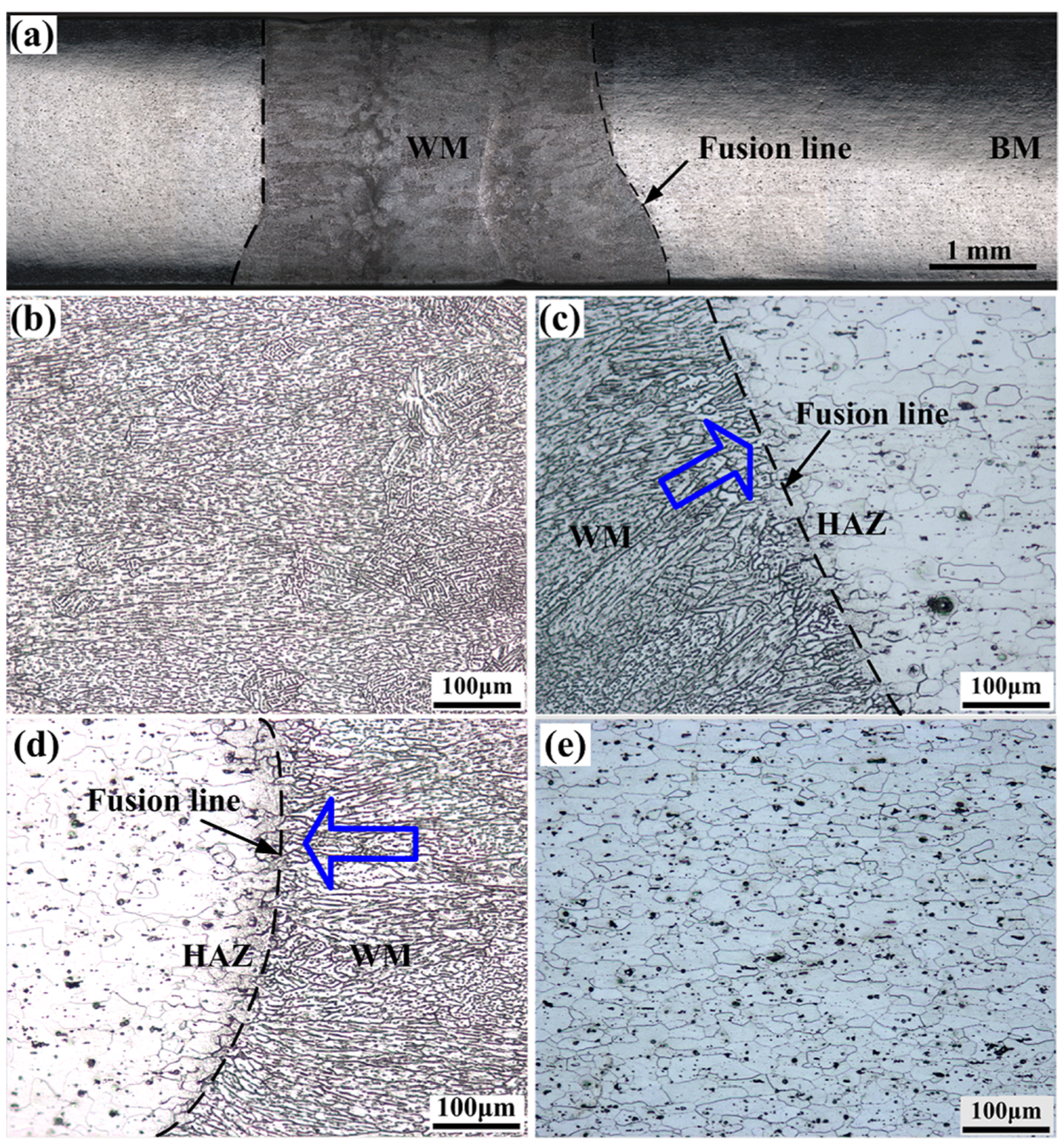

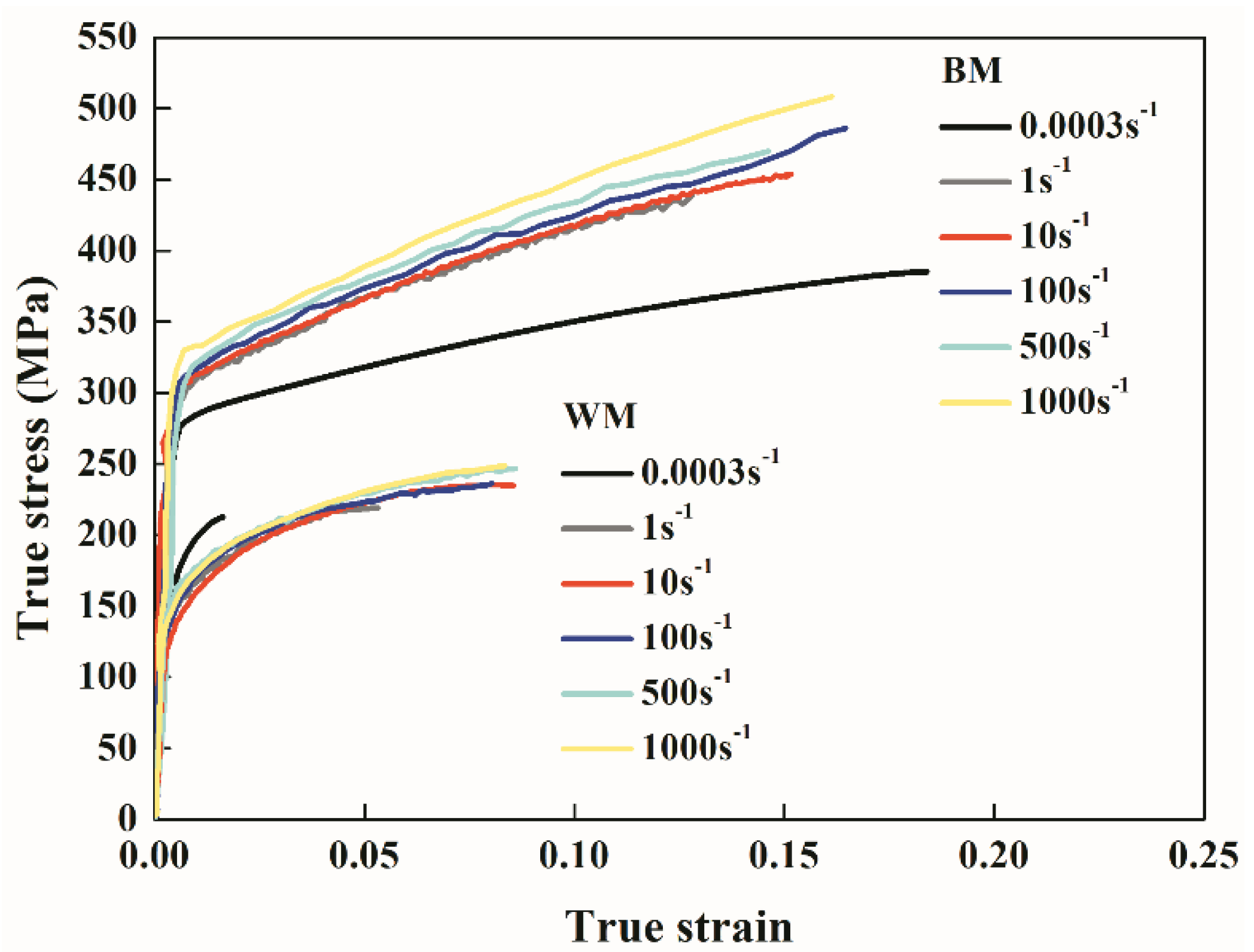

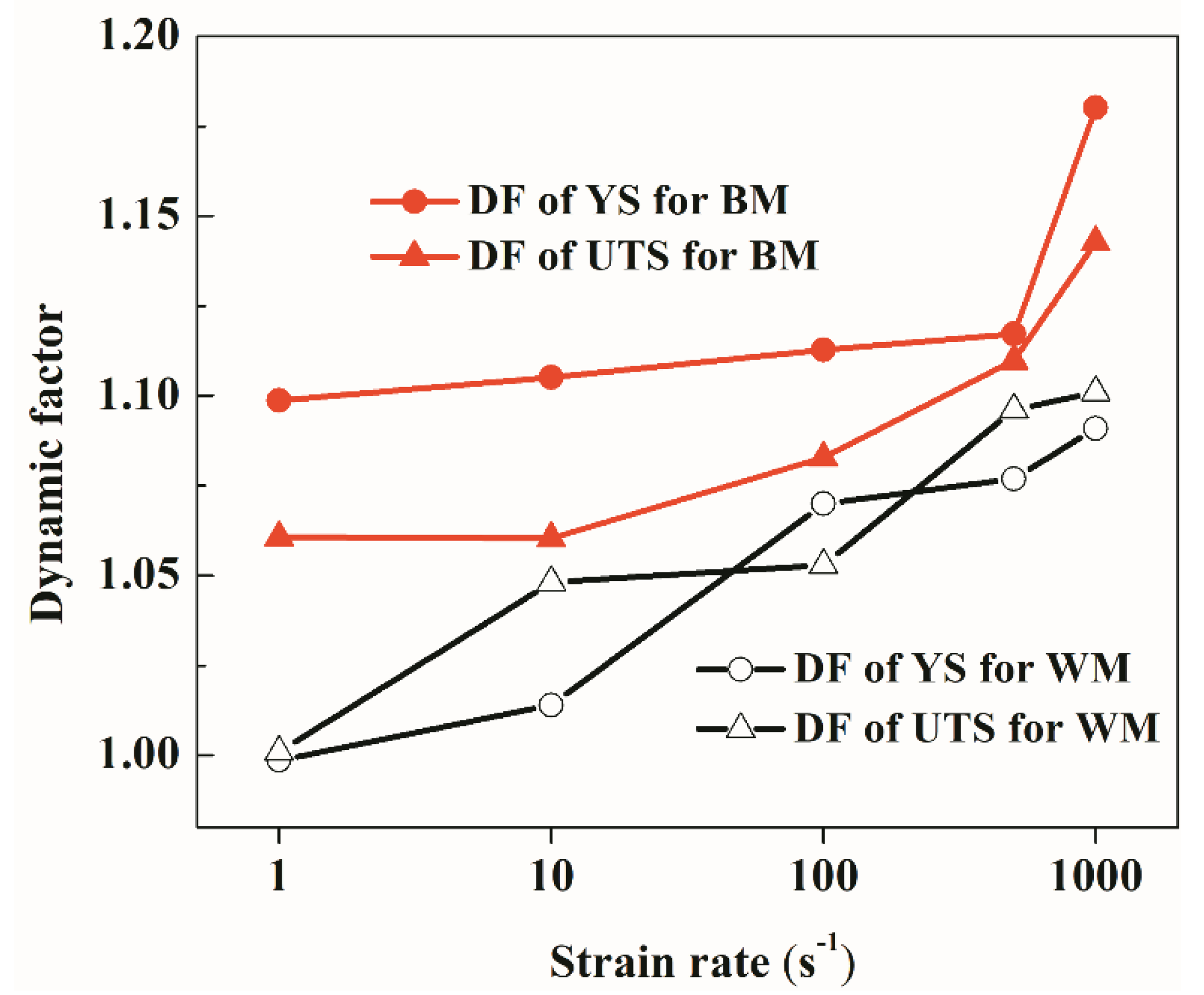
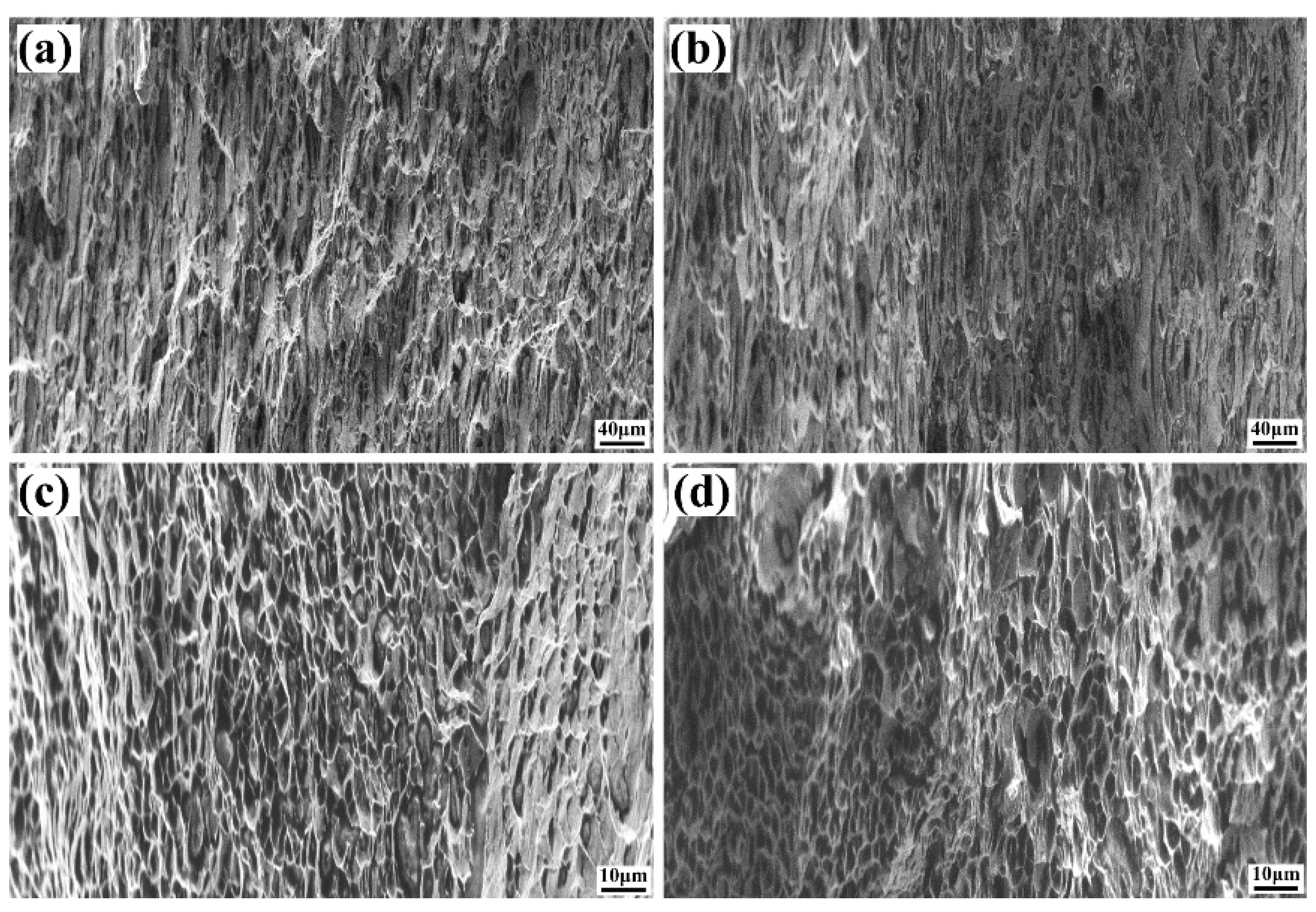
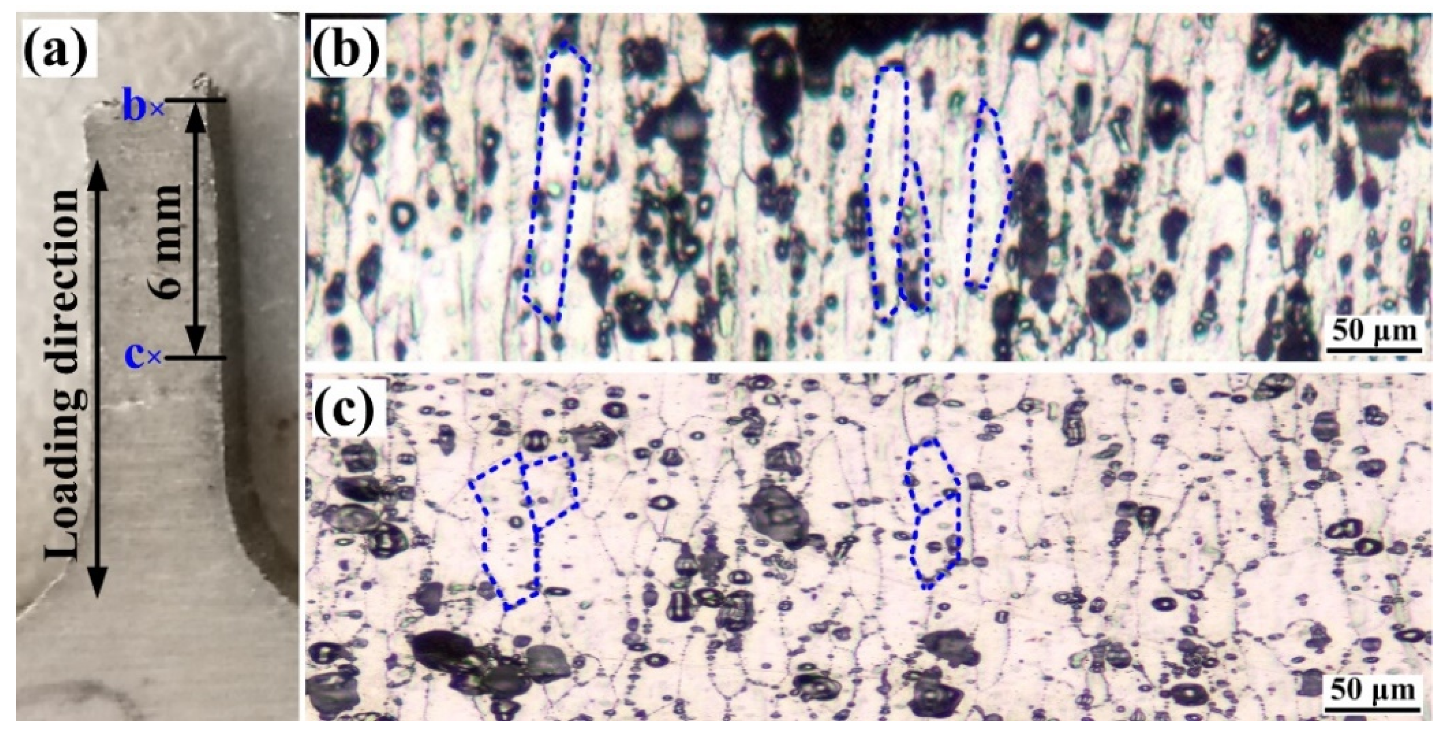

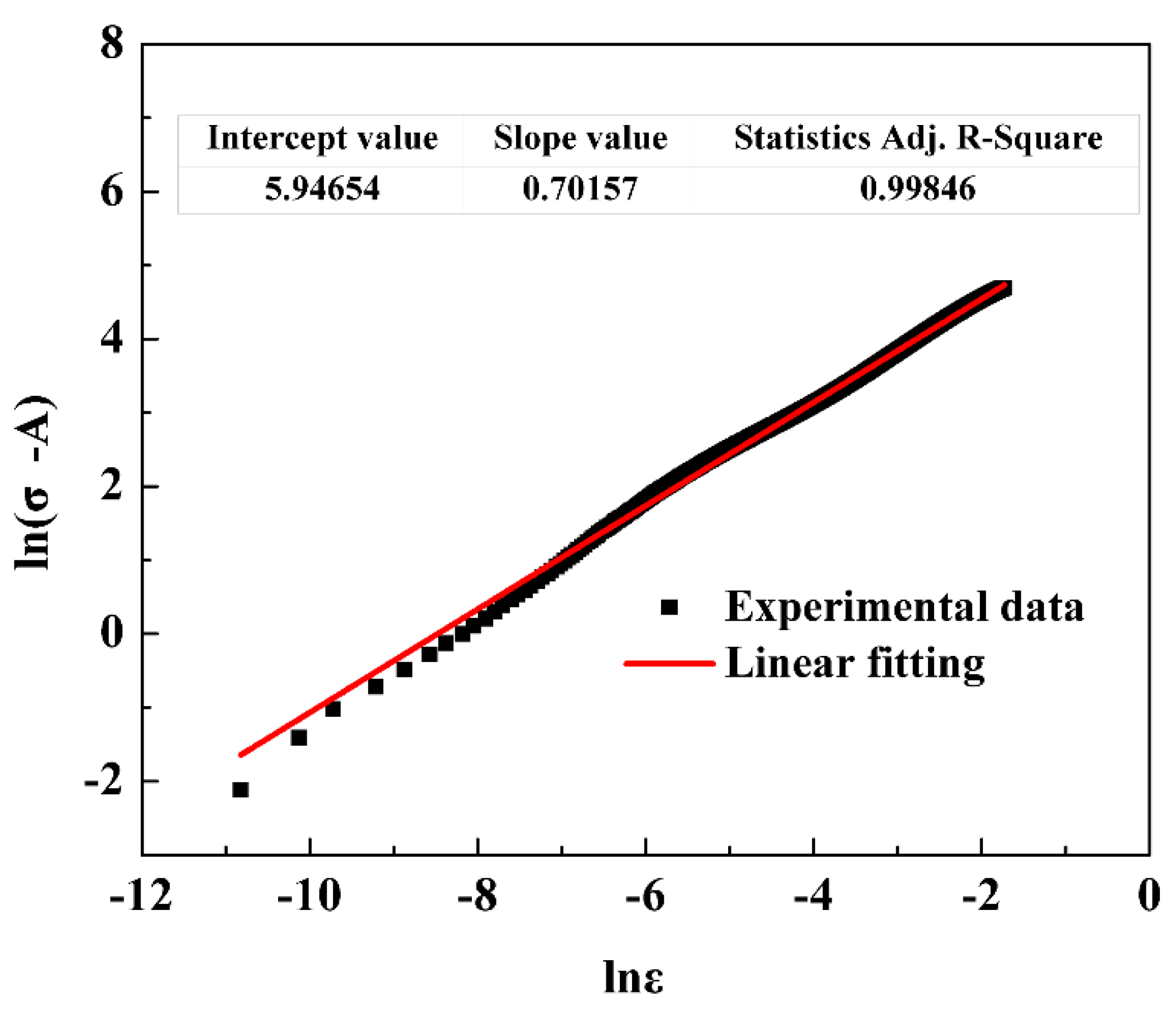
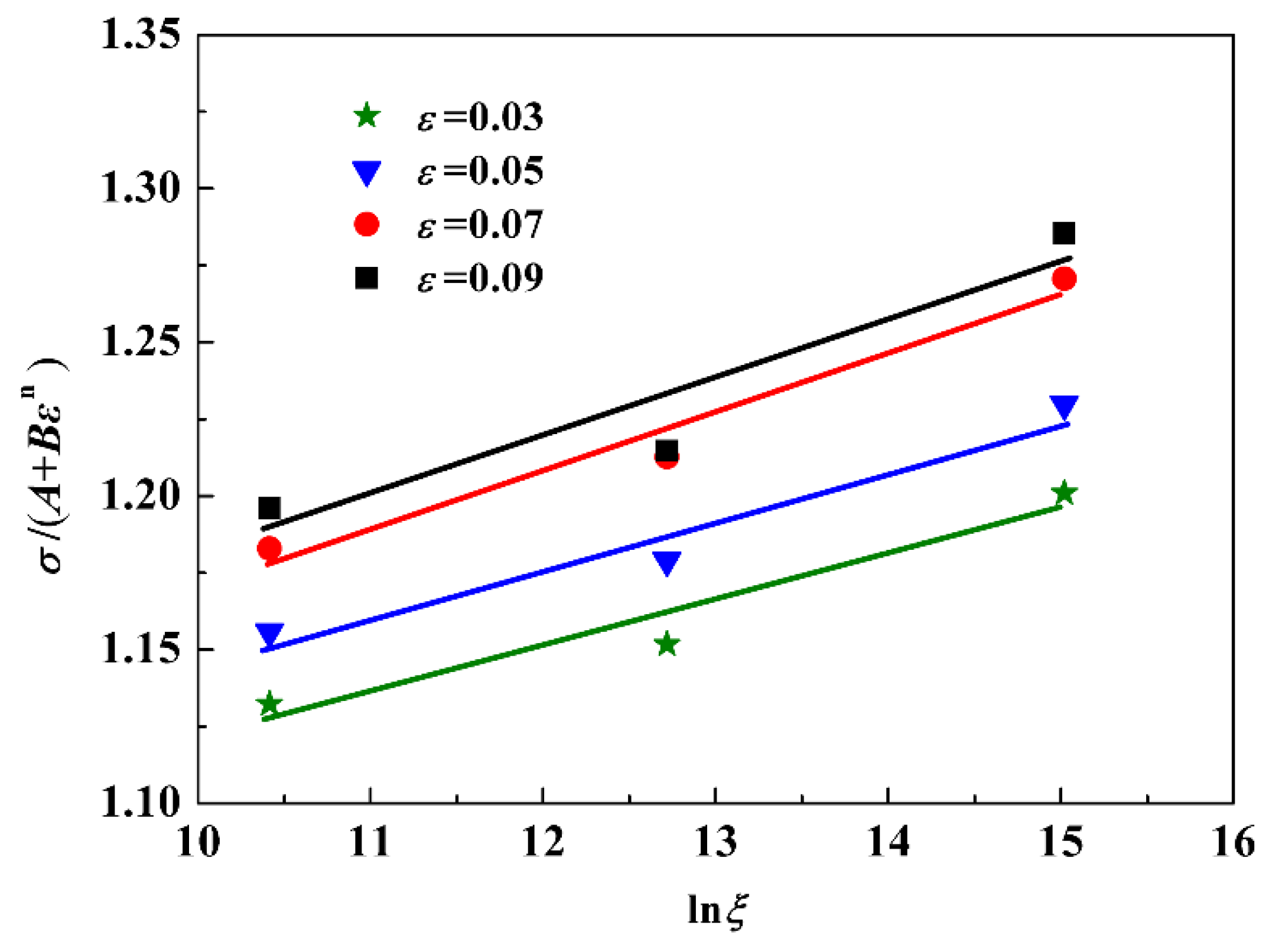
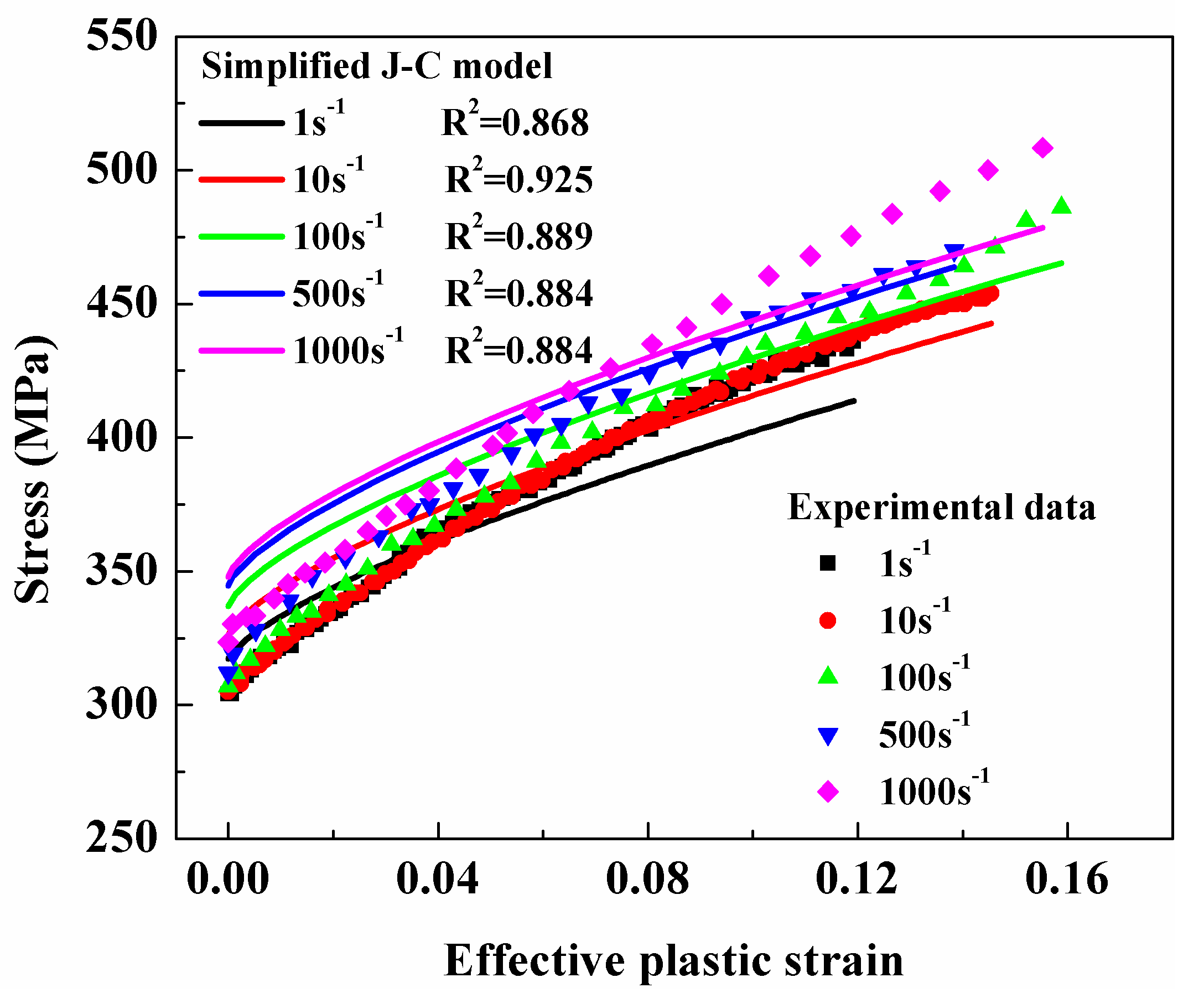


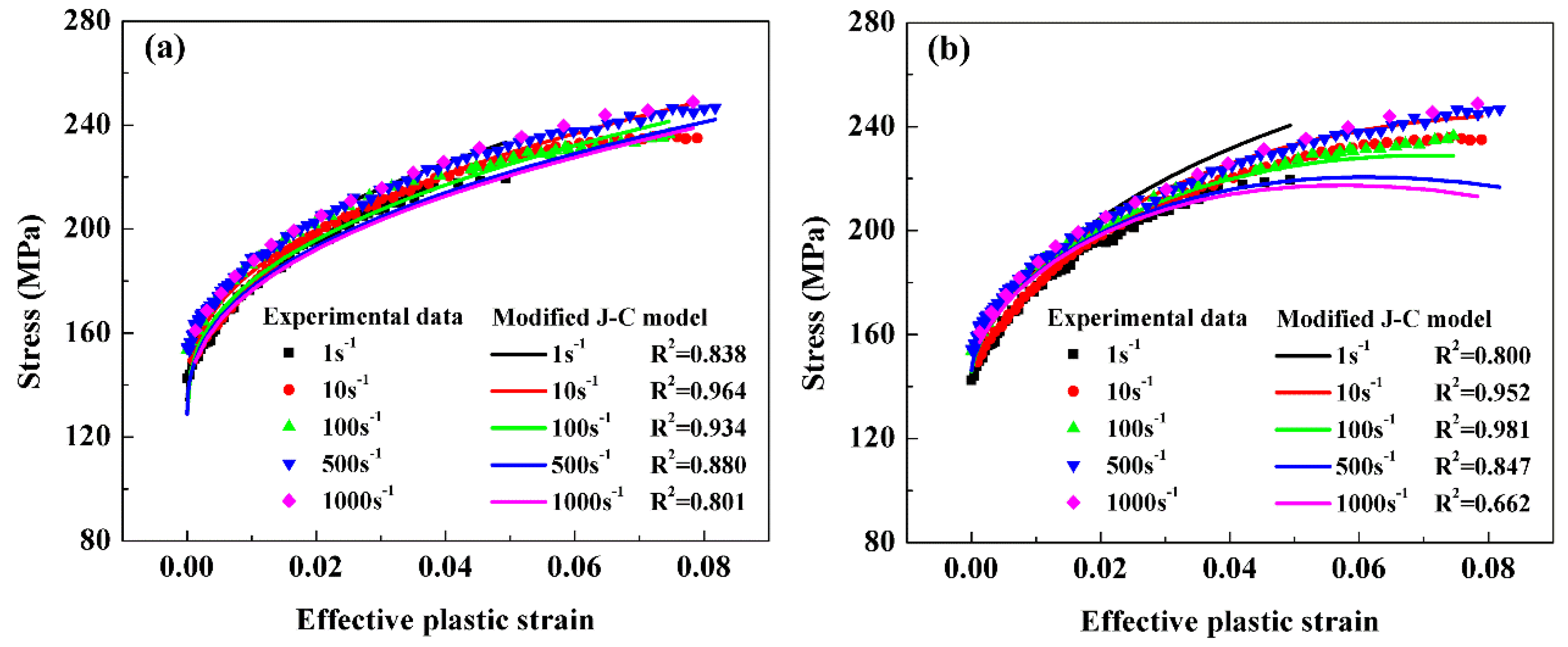
| ε | 0.03 | 0.05 | 0.07 | 0.09 |
| C | 0.01491 | 0.01609 | 0.01907 | 0.01942 |
| Strain Rate/s−1 | Base Material | Welded Material | ||
|---|---|---|---|---|
| R2 for Simplified Model | R2 for Modified Model | R2 for Simplified Model | R2 for Modified Model | |
| 1 | 0.868 | 0.898 | 0.838 | 0.800 |
| 10 | 0.925 | 0.988 | 0.964 | 0.952 |
| 100 | 0.889 | 0.966 | 0.934 | 0.981 |
| 500 | 0.884 | 0.958 | 0.880 | 0.847 |
| 1000 | 0.884 | 0.993 | 0.801 | 0.662 |
© 2020 by the authors. Licensee MDPI, Basel, Switzerland. This article is an open access article distributed under the terms and conditions of the Creative Commons Attribution (CC BY) license (http://creativecommons.org/licenses/by/4.0/).
Share and Cite
Nie, J.; Li, S.; Zhong, H.; Hu, C.; Lin, X.; Chen, J.; Guan, R. Microstructure and Mechanical Properties of Laser Welded 6061-T6 Aluminum Alloy under High Strain Rates. Metals 2020, 10, 1145. https://doi.org/10.3390/met10091145
Nie J, Li S, Zhong H, Hu C, Lin X, Chen J, Guan R. Microstructure and Mechanical Properties of Laser Welded 6061-T6 Aluminum Alloy under High Strain Rates. Metals. 2020; 10(9):1145. https://doi.org/10.3390/met10091145
Chicago/Turabian StyleNie, Jincheng, Shengci Li, Huilong Zhong, Changjing Hu, Xiangsong Lin, Jiqiang Chen, and Renguo Guan. 2020. "Microstructure and Mechanical Properties of Laser Welded 6061-T6 Aluminum Alloy under High Strain Rates" Metals 10, no. 9: 1145. https://doi.org/10.3390/met10091145
APA StyleNie, J., Li, S., Zhong, H., Hu, C., Lin, X., Chen, J., & Guan, R. (2020). Microstructure and Mechanical Properties of Laser Welded 6061-T6 Aluminum Alloy under High Strain Rates. Metals, 10(9), 1145. https://doi.org/10.3390/met10091145







